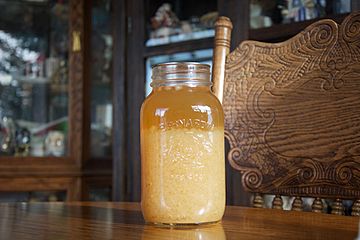List of fermented foods facts for kids
Fermented foods are special foods and drinks made with the help of tiny living things called microorganisms, like yeast or bacteria. These tiny helpers change the food in a process called fermentation. This often means they turn sugars into things like alcohol or lactic acid.
For example, yeast helps turn sugar into alcohol in drinks like beer. Other tiny helpers, like lactobacillus bacteria, are used to make foods such as yogurt and sauerkraut. Many fermented foods are made in large amounts using special industrial processes. The science of studying fermentation is called zymology.
Some pickled or soured foods are fermented. But others are simply soaked in salty water (brine), vinegar, or other sour liquids like lemon juice.
Contents
Amazing Fermented Foods
Fermented Beans and Seeds
Many delicious foods are made by fermenting beans and seeds, especially soybeans!
| Name | Image | Origin | Description |
|---|---|---|---|
| Cocoa |  |
The beans used to make chocolate are fermented first. This helps create their rich flavor. | |
| Doenjang |  |
Korea | A thick, savory paste made from fermented soybeans. It's a key ingredient in Korean cooking. |
| Miso |  |
Japan | A popular Japanese paste made from fermented soybeans, often used in soups and dressings. |
| Nattō |  |
Japan | A traditional Japanese breakfast food made from soybeans fermented with a special bacteria. It has a unique smell and slimy texture! |
| Tempeh |  |
Indonesia | A traditional Indonesian food where soybeans are fermented and pressed into a firm, cake-like form. It's often used as a meat substitute. |
Fermented Cheeses
Most cheeses (except for fresh cheeses) are fermented as part of how they are made.
| Name | Image | Origin | Description |
|---|---|---|---|
| Limburger | A soft cheese known for its strong smell. | ||
| Shanklish |  |
A type of cheese from the Middle East, often spiced and shaped into balls. |
Fermented Sauces and Spices
Fermentation helps create many flavorful sauces and condiments that add a kick to our meals.
| Name | Image | Origin | Description |
|---|---|---|---|
| Bagoong |  |
Philippines | A Filipino condiment made from fermented fish or shrimp and salt. It's very flavorful! |
| Fish sauce |  |
East and Southeast Asia | A salty liquid made from fish or tiny shrimp fermented for a long time. It's a main seasoning in many Asian dishes. |
| Gochujang | 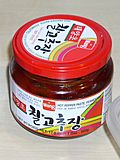 |
Korea | A spicy, sweet, and savory paste from Korea. It's made from chili powder, sticky rice, and fermented soybeans. |
| Soy sauce |  |
Korea, Japan, China, Taiwan, Philippines, Indonesia | A popular salty sauce made from fermented soybeans and grains. It's used all over Asia and beyond. |
| Vinegar | 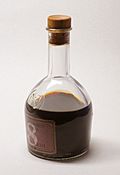 |
A sour liquid made by fermenting sugars into alcohol, then into acetic acid. It's used for cooking, pickling, and as a condiment. | |
| Worcestershire sauce |  |
Worcestershire, England | A fermented liquid sauce used to add flavor to many dishes, like steaks and hamburgers. |
Fermented Creams and Yogurts
These dairy products get their creamy texture and tangy taste from fermentation.
| Name | Image | Origin | Description |
|---|---|---|---|
| Amasi |  |
South Africa | A type of fermented milk that tastes similar to cottage cheese or plain yogurt. |
| Crème fraîche |  |
France | A rich, soured cream that is less sour than regular sour cream. |
| Kefir |  |
North Caucasus | A fermented milk drink, like a thin yogurt, made with special "kefir grains." |
| Sour cream |  |
Cream that has been fermented with lactic acid bacteria. It becomes thick and tangy. | |
| Yogurt |  |
Unknown; thought to be ancient Mesopotamia | A popular fermented milk product made by adding bacteria to milk. It comes in many flavors! |
Fermented Grains and Grain-Based Foods
Grains can be fermented to make a variety of staple foods, from breads to pancakes.
| Name | Image | Origin | Description |
|---|---|---|---|
| Appam |  |
India | A South Indian pancake made from fermented rice batter and coconut milk. |
| Bread | 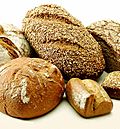 |
Worldwide | Many types of bread use yeast to make them rise. The yeast ferments sugars, creating gas bubbles that make the bread light and airy. |
| Dosa |  |
India | A thin, savory pancake or crepe made from fermented rice and black lentils. It's a common food in India. |
| Idli |  |
Indian subcontinent | Steamed savory rice cakes, popular for breakfast in Southern India and Sri Lanka. They are made from fermented black lentils and rice. |
| Injera |  |
Ethiopia | A spongy, sourdough flatbread made from teff flour. It's a national dish in Ethiopia and Eritrea. |
| Puto | 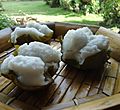 |
Philippines | Philippine rice cakes. Some kinds are made using fermentation. |
Fermented Fruits and Vegetables
Fermentation is a great way to preserve fruits and vegetables, giving them unique flavors.
| Name | Image | Origin | Description |
|---|---|---|---|
| Atchara |  |
Philippines | A sweet and sour pickle made from unripe papaya. It's often served with fried or grilled foods. |
| Kimchi |  |
Korea | A famous Korean dish made from fermented cabbage or radish, often spicy. |
| Nata de coco |  |
Philippines | A jelly-like dessert made from fermented coconut water. It's chewy and sweet. |
| Pickles | 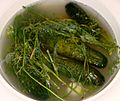 |
ancient Mesopotamia | Foods preserved by soaking them in brine or vinegar. Many pickles, like cucumbers, are fermented. |
| Sauerkraut | 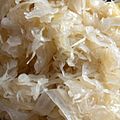 |
Germany | Finely cut cabbage that has been fermented by bacteria. It has a long shelf life and a distinctive sour taste. |
Fermented Meat and Seafood
Fermentation can also be used to preserve meats and seafood, creating strong and interesting flavors.
| Name | Image | Origin | Description |
|---|---|---|---|
| Fermented fish |  |
A traditional way to preserve fish before refrigerators existed. | |
| Hákarl |  |
Iceland | A unique Icelandic dish made by fermenting shark meat and then drying it. It has a very strong smell! |
| Salami |  |
Europe | A type of cured sausage made from fermented and air-dried meat, usually pork. It's popular across Europe. |
| Shrimp paste (Belacan) |  |
Southeast Asia, China | A strong-smelling paste made from fermented shrimp. It's used in many Southeast Asian dishes. |
| Surströmming |  |
Sweden | A Swedish dish of lightly-salted fermented Baltic Sea herring. It's famous for its very strong smell. |
Fermented Drinks and Beverages
Many drinks, from milk-based to grain-based, get their unique qualities from fermentation.
| Name | Image | Origin | Description |
|---|---|---|---|
| Ayran | 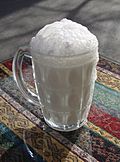 |
A cold, salty yogurt drink popular in Turkey and other countries. | |
| Beer |  |
An alcoholic drink made from fermented grains and hops. | |
| Buttermilk | 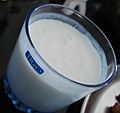 |
A fermented dairy drink, often leftover from making butter. | |
| Kefir |  |
North Caucasus | A fermented milk drink, similar to a thin yogurt, made with special "kefir grains." |
| Kombucha |  |
A fizzy, slightly sweet tea drink made by fermenting black or green tea. Many people drink it for health reasons. | |
| Kvass |  |
Eastern Europe | A low-alcohol fermented drink often made from rye bread. |
| Lassi |  |
India | A popular yogurt drink from India, often sweet or salty. |
| Tibicos (water kefir) |  |
Unknown (worldwide) | A fermented drink made with water and a special mix of bacteria and yeasts. |
| Wine |  |
Caucasus | An alcoholic drink usually made from fermented grapes. Other fruits can also be used. |


